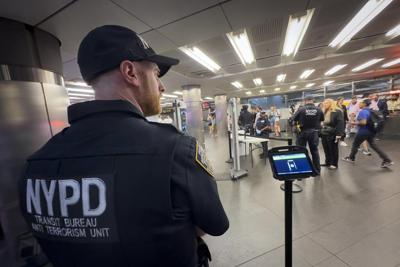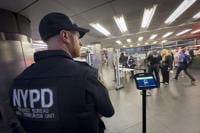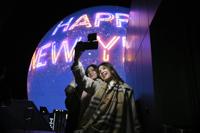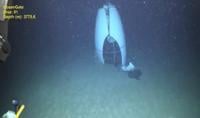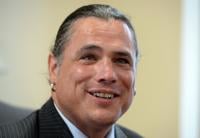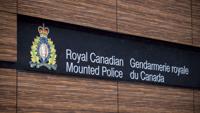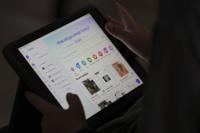NEW YORK (AP) — New York City is turning to AI-powered scanners in a new bid to keep guns out of its subway system, but the pilot program launched Friday is already being met with skepticism from riders and the threat of a lawsuit from civil liberties advocates who say the searches are unconstitutional.
The Evolv scanner — a sleek-looking weapons detector using artificial intelligence to search riders for guns and knives — was on display at a lower Manhattan subway station where Mayor Eric Adams announced the 30-day trial.
“This is good technology,” Adams said at Fulton Center near the World Trade Center.
“Would I rather that we don't have to be scanned? Yes," he added. “But if you would speak to the average subway rider, they would state that they don’t want guns on their subway system, and if it means using scanners, then bring the scanners on.”
Adams, a self-described “tech geek,” has stressed that the scanners are still in the experimental phase. The machines, already in use at baseball stadiums and other venues, will be deployed to a small number of stations and only a fraction of riders will be asked to step through them. The city has not entered into a contract with Evolv, and Adams said other companies were welcomed to pitch their own gun-detection innovations.
The scanners, about 6 feet (1.8 meters) tall, feature the logo of the city's police department and a multicolor light display. When a weapon is detected, an alert is sent to a tablet monitored by a pair of NYPD officers. The system is not supposed to alert everyday items, such as phones and laptops — though a reporter's iPad case set it off Friday.
The scanners drew immediate protest from civil liberties advocates. The New York Civil Liberties Union and the Legal Aid Society said they would sue the city if the technology is rolled out widely, alleging the searches violated the constitutional rights of riders.
“City officials have admitted that these scanners are primarily to combat some riders’ ‘perceptions’ that they are unsafe on the subway — this is not a justifiable basis to violate the Constitution,” said NYCLU attorney Daniel Lambright.
The scanners also spurred concerns from riders who said it isn't practical or plausible to subject millions of commuters to security screenings.
“It’s not going to work," said Dre Thomas, 25, shaking his head at the device. “It’d have to be at every point in the subway. I don’t see how that’s possible. It seems to me like another way to waste taxpayer money.”
Wyatt Hotis, 29, said he thought the scanners were a good idea but “not the root of the issue" when people getting pushed onto the tracks were a bigger safety concern. Hotis instead suggested adding guardrails and barriers to the platforms, along with more officers to patrol them.
Margaret Bortner, among the first riders to go through the scanner, described the 30-second process as painless — but didn't see the need to have them at every station.
"There are more important things officers should be doing," she said.
Though there have been high-profile incidents, like on a Brooklyn train that left 10 people wounded, crime in the New York City subway system has fallen in recent years. Overall, violent crime in the system is rare, with train cars and stations being generally as safe as any other public place.
So far this year, subway crime is down 8% through July 21 compared with the same period in 2023, according to police data. Last year, there were five killings in the subway, down from 10 the year prior, according to police.
Adams has long discussed the possibility of adding weapons detectors to the subway system. He suggested this week that “eventually, every turnstile is going to be able to identify if someone is carrying a gun,” but doing so could require the city to deploy thousands of police officers to respond to gun alerts.
Experts have also expressed doubts about the feasibility of adding the technology to the city’s sprawling subway system, which includes 472 stations with multiple ways in and out. Fulton Center, the subway hub where the mayor spoke, illustrates the challenges of deploying the detectors in a system designed to be as accessible as possible.
There are multiple entrances spread out over several blocks, with dozens of turnstiles used by as many as 300,000 riders a day. During rush hour, they are often sprinting to catch a train. Anyone who wanted to bring a gun in without passing through a scanner could simply walk to another entrance or a nearby station.
The CEO of Evolv, Peter George, has himself acknowledged that subways are “not a great use-case” for the scanners,
Evolv has said that its scanning system uses artificial intelligence to screen up to 3,600 people per hour, quickly detecting the “signatures” of guns, knives and explosives while not alerting cell phones and other metal devices.
The company has faced a spate of lawsuits in recent years, along with federal probes into its marketing practices. Evolv told investors last year that it was contacted by the Federal Trade Commission and in February said it had been contacted by the U.S. Securities and Exchange Commission as part of a “fact finding inquiry.”
Earlier this year, investors filed a , accusing company executives of overstating the devices’ capabilities and claiming that “Evolv does not reliably detect knives or guns.” The company has that it is being targeted by a misinformation campaign by those “incentivized to discredit the company.”
New York City has experimented with a variety of security measures to ensure the protection of its vast subway system. In 2005, the NYPD ran a pilot project aimed at examining the feasibility of using explosive detection technology in the subways.
Then, the department began doing random searches of people’s bags as they entered the subway system. That effort was also rolled out with much fanfare, but such bag checks — while not completely abandoned — are rare today.
__
Associated Press reporter Karen Matthews contributed to this report.

